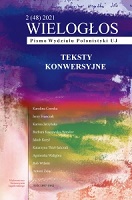Transfiguration as World- -Making Practice of Conversion: Being Always Converting as Theo-Poetics from Norman O. Brown to Bob Dylan
Transfiguration as World- -Making Practice of Conversion: Being Always Converting as Theo-Poetics from Norman O. Brown to Bob Dylan
Author(s): Rob WilsonSubject(s): Music, Sociology of Art, Sociology of Literature
Published by: Wydawnictwo Uniwersytetu Jagiellońskiego
Keywords: conversion; Norman O. Brown; Bob Dylan; transfiguration;
Summary/Abstract: By a transfigurative recoding of selfhood and a quasi-Biblical intertextual analogizing of historical events into figures across space and time, Bob Dylan shaped his initial conversion as a poetic name-change from Zimmerman-to-Dylan (as he would later write more broadly across the larger body of his poetry). This theo-poetic transformation of identity into a more poetic and spiritual being is what Norman O. Brown theorized, in Love’s Body and Apocalypse and/or Metamorphosis if not throughout his works early and late, as the world-transforming tactic of “figural interpretation, [that] discovered world-historical significance in any [everyday trivial] event–an event which remains trivial for those who do not have eyes to see.” Transfiguration for Brown (as for the metaphor-rich Dylan) was not just a figural, intertextual, or rhetorical shift of tropes, it also implied all the more so a biomorphic metamorphosis of self and the world, soul and matter, bios and logos. This shift of self and the world occurs via a morphological transformation of terms and forms in the event of metanoia. Such metaphoric twists and turns of apocalyptic metamorphosis aim to remake the world into more fluid, multiple forms of becoming and uplifting as befits what a flourishing imagination longs for (via transubstantiation) and what Brown defines (and Dylan performs as) so many feats of transfigurative metamorphosis: what Brown calls “Metamorphosis, or transubstantiation.” “Transubstantiate my form, says Daphne [as the muse to poet Apollo, archetypal Greco-Roman figure] through the incarnational claim, ‘be leaf’ (belief).” In this essay, Brown will take on the role of the muse Daphne provoking and inspiring poet-figures like Apollo to embrace what he defines as the process of “be leafing” (believing) patterns. Belief would take place relentlessly in a world-transforming poet like Bob Dylan, in many ways the most important poet of his world era.
Journal: Wielogłos
- Issue Year: 2021
- Issue No: 48
- Page Range: 5-23
- Page Count: 18
- Language: English

